
温暖化問題 地球温暖化のエセ科学 G20 ICAP comment
2020年までの温室効果ガスの削減目標 経済団体の温暖化意見広告
ノーベル平和賞にアル・ゴアとIPCC How to Cool the Globe
| IPCC報告 第一作業部会(科学) IPCC報告書案 温暖化 今世紀末時点 最悪6.4度 (ブログ http://www.knak.jp/blog/2007-02-1.htm#ipcc) 第二作業部会(影響) 国連バネルが報告採択 温暖化、全地球に影響 第3作業部会(対策) |
温暖化対策 合計13業種が目標引き上げ 電機・電子など4業界も
Inconvenient Truths for Al Gore Bjorn Lomborg
化学関連産業5団体で「化学産業団体・地球温暖化対策協議会」を設立
環境省 平成17年度税制改正(租税特別措置)要望 環境税新設
反環境税意見広告に何を見るか 市民のための環境学ガイド 2004/11/14
2005/10 炭素1トンで環境税2400円 環境省が具体案発表
廃プラ燃焼時CO2が半減 東京理科大ベンチャーが新添加剤を開発
地球を救う税システムの活用
(温暖化防止のための税制の国際的動向)
株式会社 三菱総合研究所 林 希一郎
http://www.iis-net.or.jp/shinko/Topics.nsf/0/AC4AB947AF13911049256CDC001C971B?OpenDocument
| 表1 各国のエネルギー製品への課税状況と温暖化対策税の概要
|
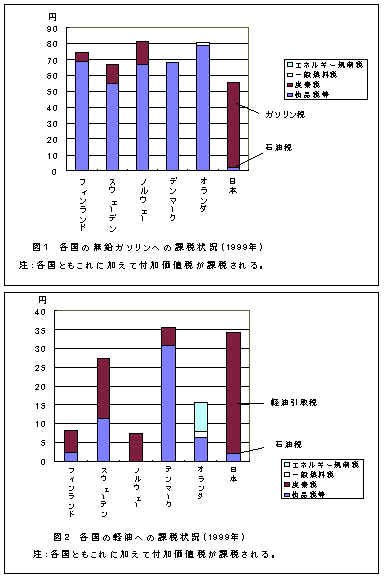
「環境税」に関する見解
http://www.jisf.or.jp/kankyo/images/030919position_paper.pdf
平成15年9月19日
(社)日本鉄鋼連盟
1.地球温暖化問題は世界全体で取り組むべき課題
2.地球温暖化問題は各主体(国、自治体、企業、国民)が責任を持って取り組む課題
3.新たな「環境税」の導入は、鉄鋼業に壊滅的な打撃を与える
4.他国への鉄鋼生産移転は地球規模での温暖化防止に逆行
5.「環境税」ありきを前提とした議論に踏み込むことに反対
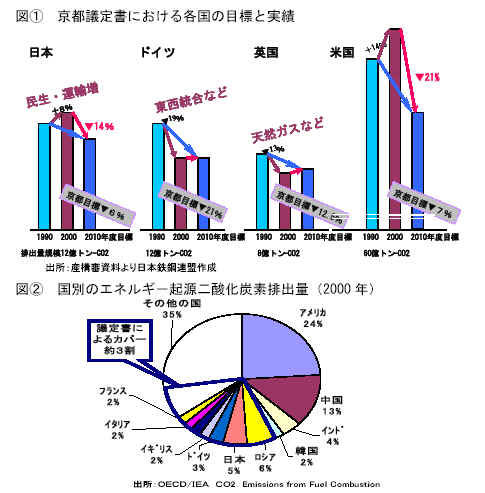 |
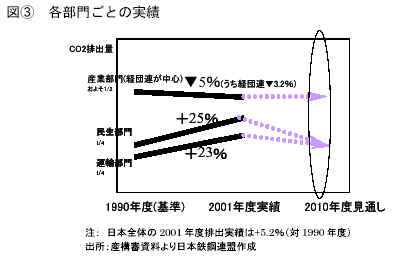 |
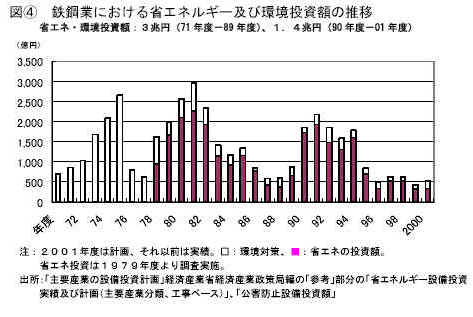 |
|
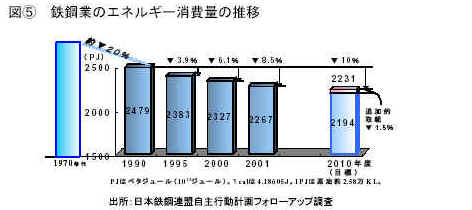 |
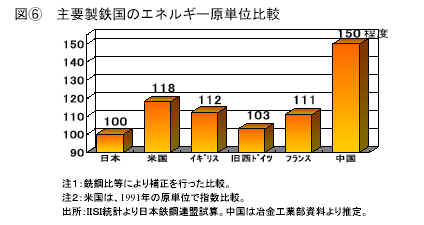 |
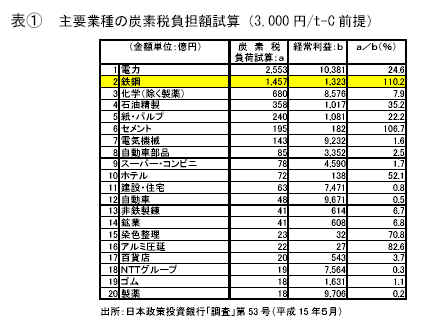 |
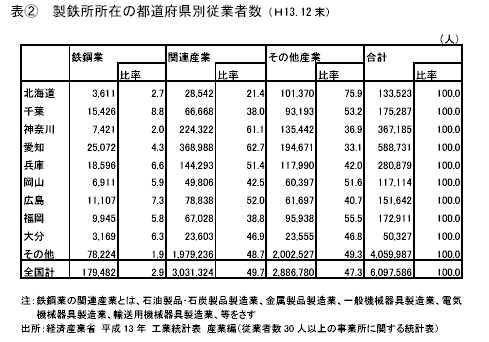 |

2004年10月19日
化学関連産業5団体で「化学産業団体・地球温暖化対策協議会」を設立
社団法人 日本化学工業協会
石油化学工業協会
日本ソーダ工業会
塩ビ工業・環境協会
日本化学繊維協会
化学業界としましては、温暖化対策を目的の一つとして昨年改正された石油石炭税により、既にエネルギーに対して高額な税を負担しています。温暖化対策税は、エネルギーに新たに追加される税であり、同税による所期の効果が疑問視されているのみならず、エネルギー消費税の更なる増税により、わが国産業の国際競争力を失わせ、産業の空洞化を招来し、CO2の削減義務を負わない途上国等への生産移転により地球規模でのCO2排出量が増加するおそれがある等の理由から温暖化対策税の導入には反対です。
また、国内排出量取引制度につきましては、政府が企業のエネルギー使用量を事前に定める規制的・統制経済的な色合いの濃い政策であり、本来、市場メカニズムによって図られるべき産業構造の転換・高度化をいたずらに歪めるおそれがあるので反対です。
日本経済新聞 2004/10/21
温暖化ガス排出
企業に報告義務 政府、通常国会に法律
1万4000ヵ所 自主削減促す
政府は先進国に温暖化ガスの排出削減を求めた京都議定書が来春にも発効することを踏まえ、大企業を中心に温暖化ガスの排出量を国に報告することを義務づけ、公表する方針だ。約1万4千カ所の工場や事業所ごとの排出量を毎年報告させる。環境問題で批判を避けたい企業心理を利用し自主削減を加速する。削減が進まない企業には省エネ努力を強く求める。産業界は規制強化と反発する可能性が大きい。
一方、報告義務づけに産業界の反発は必至。日本経団達は「報告・公表の目的があいまいだ」と指摘。将来の排出上限枠の割り当てにつながり、企業活動が制約されることを強く警戒している。
京都議定書の骨子
http://www.mofa.go.jp/mofaj/gaiko/kankyo/kiko/cop3/k_koshi.html
| 1.数量目的 | ||||
| ●対象ガスの種類及び基準年 | ||||
| ・二酸化炭素、メタン、亜酸化窒素(1990年を基準年) ・HFC、PFC、SF6(1995年を基準年とすることができる) |
||||
| ●吸収源の扱い | ||||
|
||||
| ●約束期間 | ||||
| ・第1期は、2008年~2012年の5年間 | ||||
| ●先進国及び市場経済移行国全体の目標 | ||||
| ・少なくとも5%削減 | ||||
| ●主要各国の削減率(全体を足し合わせると5.2%の削減) | ||||
| ・日本:-6% 米国:-7% EU:-8% カナダ:-6% ロシア:0% 豪州:+8% NZ:0% ノルウェー:+1% |
||||
| ●次期約束期間への繰り越し(バンキング) | ||||
| ・認める | ||||
| ●次期約束期間からの借り入れ(ボローイング) | ||||
| ・認めない | ||||
| ●共同達成 | ||||
| ・欧州共同体などのように複数の国が共同して数量目的を達成することを認める | ||||
| ●排出量取引 | ||||
| ・認める。締約国会合において、ガイドライン等を決定する。 | ||||
| ●共同実施 | ||||
| ・先進国間の実施。 | ||||
| 2.途上国の義務の実施の促進 | ||||
| ● | 途上国を含む全締約国の義務として、吸収源による吸収の強化、エネルギー効率の向上等詳細に例示。 | |||
| 3.クリーン開発メカニズム | ||||
| ● | 先進国とのプロジェクトにより、途上国の持続可能な成長に資すると共に、右プロジェクトにより生じた温室効果ガス排出の削減を活用することにより、先進国の数量目的達成にも使えることとするもの。 | |||
| 4.資金メカニズム | ||||
| ● | 条約で規定された資金メカニズム(GEF)が引き続きこの議定書の資金メカニズムであることを確認。 | |||
| 5. | 発効要件 | |||
| ● | 議定書を締結した国数が55カ国以上であり、且つ締結した附属書Ⅰ国の1990年におけるCO2の排出量が同年における附属書Ⅰ国によるCO2の総排出量の55%を越えることを発効要件として規定。 | |||
| *(採択されなかったもの) | ||||
| ● | 途上国の自発的な参加についての条文は、途上国の反対により最後の段階で削除され、又、米国が主張していたエボルーションについても見送られた。 | |||
毎日新聞 2004/10/25 環境省 環境税新設 予算申請
環境税導入の是非
京都議定書の発効は確実、温室効果ガスの排出削減対策に新税は必要か
政治決断こそがカギ
石 弘光 一橋大学長
京都議定書の目標達成に向けた対策を
税制改革でどう取り入れるかが課題に
産業界は自主的削減に取り組んでいる
税新設により国際競争力と景気に影響
排出削減に強い効果
足立治郎 「環境・持続社会」研究センター(JACSES)事務局長
温暖化防止型の経済社会に変革が必要
環境省は具体的で詳細な制度の提案を
世界銀行「バイオ炭素基金」への出資について
http://www.sumitomo-chem.co.jp/japanese/gnews/news_pdf/20050323_1.pdf
住友化学は、世界銀行が設立したバイオ炭素基金へ2017年までに合計250万USドルを出資することといたしました。これにより、2017年までの13年間で約40万炭素クレジット※1の獲得が期待できます。
バイオ炭素基金は、森林保全、植林、バイオ燃料などのプロジェクトに投資し炭素クレジットを獲得することを目的として世界銀行が2004年5月に設立した基金で、京都議定書で定めた京都メカニズム※2のうち、途上国を対象とした「クリーン開発メカニズム」(Clean Development Mechanism※3)と先進国同士で行う「共同実施」(Joint Implementation※4)を活用したものです。
※1 炭素クレジット
温室効果ガス削減を目的としたプロジェクトを実施し、その結果生じた削減・吸収量に応じて発行される排出権のことで、これを削減目標達成に利用することができる。
※2 京都メカニズム
温室効果ガス削減をより柔軟に行うために京都議定書で制定された経済的メカニズム。日本のようなエネルギー効率が高い国では、自国のみでの削減には限界があることから、他国での削減実施に投資を行い、削減された量またはその一部が自国の排出削減量して認められることになっている。
※3 Clean Development Mechanism(CDM)
京都メカニズムの1つで、先進国が発展途上国と協力して温室効果ガス削減のプロジェクトを行い、削減・吸収された量(炭素クレジット)をプロジェクト参加者間で分け合う仕組み。
※4 Joint Implementation(JI)
京都メカニズムの1つで、先進国同士でプロジェクトを行い、削減・吸収された量(炭素クレジット)をプロジェクト参加者間で分け合う仕組み。
2005/10/18 毎日新聞夕刊
廃プラ燃焼時 CO2が半減 新添加剤を開発 東京理科大ベンチャー
プラスチックに数%加えるだけで、燃焼時の二酸化炭素(CO2)発生量を半減させる添加剤を開発したと17日、東京理科大の教員らが出資するベンチャー企業「日本ポロン」(東京都渋谷区)などが発表した。
添加剤の商品名は「ナノハイブリッドカプセル2」。酸素を吸着する性質を持った脂質成分でできた粒子で、直径を50ナノメートル(ナノは10億分の1)まで小さくしたことで、酸素を吸着する能力が飛躍的に高くなったという。
炭素1トンで環境税2400円 環境省が具体案発表
地球温暖化対策を進めるための環境税について、環境省は25日、具体案を発表した。税率は化石燃料に含まれる炭素1トンあたり2400円。導入は07年1月とし、年間約3700億円の税収を見込み、全額を温暖化対策にあてる。1世帯あたりの負担額は年間約2100円となる見通し。今後、自民、公明両党の環境部会に提示し、年末の税制改正に向けて実現を目指す。
課税対象となるのは、石炭や重油、灯油や発電用燃料など。ガソリン、軽油、ジェット燃料については、原油価格高騰などを受け、当面は課税対象から外すこととした。
毎日新聞 2007/1/19
温暖化 最悪6.3度 今世紀末時点 IPCC予測 懐疑論を否定
地球温暖化に対する最新の分析や予測を集約した国連の「気候変動に関する政府間パネル(IPCC)」第4次報告書案を、毎日新聞は入手した。地球の平均気温の上昇や氷雪の融解増などから、人間活動による温室効果ガスの排出で温暖化が確実に起きていると強調。温暖化への懐疑論を否定する内容となった。
温暖化対策 「猶予なし」IPCC報告書案 精密分析で立証
| IPCC第4次報告書案骨子 ▽二酸化炭素(CO2)の大気中濃度は産業革命前の280ppm(ppmは100万分の1)から2005年には379ppmに上昇した。 ▽2000~05年の化石燃料からのCO2年平均排出量は90年代に比べ12%増加した。 ▽南極の氷床から得られた過去65万年のデータから、現在のC02やメタンの大気中濃度は、産業革命前に比べてはるかに高い。 化石燃料の使用、農業が主因。 ▽地球の平均気温の上昇、氷雪の融解の増加などから温暖化は明白。 ▽21世紀末の平均気温は20世紀末に比べ1~6.3度上昇と予測。 ▽21世紀末の海水面は20世紀末に比べて19~58センチ上昇と予測。 ▽温暖化で海水のpHは0.14~0.35下がり、酸性化が進む。 ▽地球の平均気温が1.5~2.5度高まれば、20~30%の生物種が絶滅する恐れがある。 ▽4度上昇で30億人が水不足に直面する。 |
2007/1/23 日本経済新聞夕刊
温暖化ガス 米で削減義務化提言 GEなど10社経営者ら 10年間で最大10%
ゼネラル・エレクトリツク(GE)など米大手企業10社の経営者は22日、環境政策のシンクタンクなどと共同で、温暖化ガスの削減を義務化する立法を促す提言をまとめた。今後10年で二酸化炭素(CO2)などの温暖化ガスを最大10%削減するよう求めている。議会でも超党派で義務化を支持する動きが出ており、削減目標設定に消極的なブッシュ政権に温暖化対策を促す圧力が一段と高まってきた。
United States Climate Action Partnership (USCAP) http://www.us-cap.org/
USCAP is a new alliance of major businesses and leading climate and environmental groups that have come together to call on the federal government to enact legislation requiring significant reductions of greenhouse gas emissions.
After a year of dialogue and collaboration, the group produced a set of principles and recommendations to guide the formulation of a regulated economy-wide, market-driven approach to climate protection.
This unique alliance
includes a number of major corporations:
Alcoa, BP America, Caterpillar Inc., Duke Energy, DuPont, FPL
Group, General Electric, Lehman Brothers, PG&E Corporation
and PNM Resources - and
four non-governmental organizations including: Environmental
Defense, Natural Resources Defense Council, Pew Center on Global
Climate Change and World Resources Institute.
The group believes that swift legislative action on the USCAP solutions-based proposal, entitled A Call for Action, would encourage innovation, enhance America's energy security, foster economic growth, improve our balance of trade and provide critically needed U.S. leadership on this vital global challenge.
"We, the members of the U.S. Climate Action Partnership, pledge to work with the President, the Congress, and all other stakeholders to enact an environmentally effective, economically sustainable, and fair climate change program consistent with our principles at the earliest practicable date."
日本経済新聞 2007/2/2
E∪が温暖化ガス10%削減法案 石油会社、義務に 2020年期限
欧州連合(EU)の欧州委員会は1月31日、石油会社に二酸化炭素(CO2)などの温暖化ガス削減を義務付ける法案を提出した。石油の精製や輸送、消費などの過程で20年までに温暖化ガスを10%削減するよう求めた。
| EUが進める温暖化ガスの削減対策 | ||||||||
|
2007/1/31 AP
EU Proposes Cleaner Fuel Requirements
The European Commission on Wednesday proposed requirements to make fuel for transport vehicles cleaner as of 2011 to cut emissions of gasses that contribute to global warming.
Under the plan, fuel suppliers would have to cut greenhouse gas emissions by 1 percent as of 2011 and achieve a 10 percent overall cut by 2020.
毎日新聞 2007/4/3
米連邦最高裁 温室効果ガス規制 政府に促す判決
米国のマサチューセッッ州など12州政府や環境保護団体が連邦環境保護庁(EPA)を相手取り、自動車からの二酸化炭素(CO2)など温室効果ガスの排出規制を求めていた訴訟で、米連邦最高裁は2日、EPAに規制を強く促す判決を下した。
最高裁の多数意見を代表したスティーブンス判事は判決で、CO2を含む温室効果ガスは同法が規定する大気汚染物質に当てはまり、EPAは規制権限を持つとの判断を示した。さらに、EPAが排出規制を拒否Lたため「実際または差し迫った」被害の危険性が生じていると指摘、同庁の政策見直しを強く求めた。
判決は、地球温暖化に関連する被害は「深刻」と説明。EPA自身が対処の必要性を認めており、温室効果ガスと温暖化との因果関係を否定できていないと指摘した。
日本経済新聞 2007/4/7
国連バネルが報告採択 温暖化、全地球に影響
湿地最大30%消失 動植物30%絶滅も
国連の気候変動に関する政府間パネル(IPCC)第二部会は6日、温暖化が「地球規模で目に見える影響を及ぼし始めた」とする報告書をまとめた。将来的に海面上昇や洪水で年間に数百万人が被害にさらされる恐れがあると警告。平均気温の上昇幅を1990年比で2-3度に抑えなければ世界的に損失が拡大すると警鐘を鳴らした。
| 平均気温上昇の主な影響(1990年比) 1度上昇なら…最大30%の動植物の種が絶滅の恐れ 2度上昇なら…数億人が水不足に直面 洪水と暴風雨による損害の拡大 3度上昇なら…サンゴが広範囲で死滅 4度上昇なら…沿岸部で年数百万人に洪水被害 約30%の沿岸湿地が消失 |
温暖化、危機感に温度差
国連パネル報告 欧州に悲観論、米中が反発 原案より数値縮小
安保理でも温暖化討論
気温2ー3度上昇なら日本も被害拡大
西日本の降水量20%増/花粉症が増加
結論
Observational evidence from all continents and most oceans shows that many natural systems are being affected by regional climate changes, particularly temperature increases.
A global assessment of data since 1970 has shown it is likely that anthropogenic warming has had a discernible influence on many physical and biological systems.
Other effects of regional climate changes on natural and human environments are emerging, although many are difficult to discern due to adaptation and non-climatic drivers.
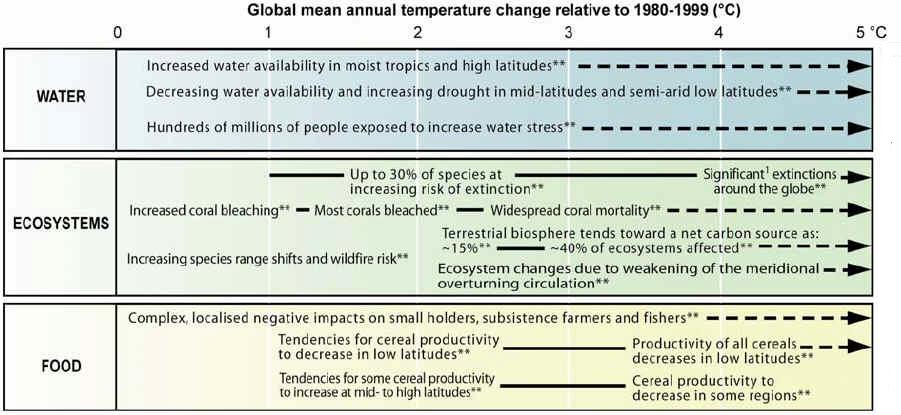 |
 |
http://www.ipcc.ch/SPM6avr07.pdf
More specific information
is now available across a wide range of systems and sectors
concerning the nature of future impacts, including for some
fields not covered in previous assessments.
Fresh
water resources and their management
By mid-century,
annual average river runoff and water availability are projected
to increase by 10-40% at high latitudes and in some wet tropical
areas, and decrease by 10-30% over some dry regions at
mid-latitudes and in the dry tropics, some of which are presently
water stressed areas. In some places and in particular seasons,
changes differ from these annual figures.
Drought-affected
areas will likely increase in extent. Heavy precipitation events,
which are very likely to increase in frequency, will augment
flood risk.
Adaptation
procedures and risk management practices for the water sector are
being developed in some countries and regions that have
recognised projected hydrological changes with related
uncertainties.
In the course of
the century, water supplies stored in glaciers and snow cover are
projected to decline, reducing water availability in regions
supplied by meltwater from major mountain ranges, where more than
one-sixth of the world population currently lives.
Ecosystems
The resilience of
many ecosystems is likely to be exceeded this century by an
unprecedented combination of climate change, associated
disturbances (e.g., flooding, drought, wildfire, insects, ocean
acidification), and other global change drivers (e.g., land use
change, pollution, over-exploitation of resources).
Over the course of
this century net carbon uptake by terrestrial ecosystems is
likely to peak before midcentury and then weaken or even
reverse11, thus amplifying climate change.
Approximately
20-30% of plant and animal species assessed so far are likely to
be at increased risk of extinction if increases in global average
temperature exceed 1.5-2.5oC.
For increases in
global average temperature exceeding 1.5-2.5°C and in concomitant atmospheric
carbon dioxide concentrations, there are projected to be major
changes in ecosystem structure and function, species’ecological interactions, and
species’ geographic ranges, with
predominantly negative consequences for biodiversity, and
ecosystem goods and services e.g., water and food supply.
The progressive
acidification of oceans due to increasing atmospheric carbon
dioxide is expected to have negative impacts on marine shell
forming organisms (e.g., corals) and their dependent species.
Food,
fibre and forest products
Crop productivity
is projected to increase slightly at mid to high latitudes for
local mean temperature increases of up to 1-3°C depending on the crop, and then
decrease beyond that in some regions.
At lower latitudes,
especially seasonally dry and tropical regions, crop productivity
is projected to decrease for even small local temperature
increases (1-2°C), which would increase risk of
hunger.
Globally, the
potential for food production is projected to increase with
increases in local average temperature over a range of 1-3°C, but above this it is projected
to decrease.
Adaptations such as
altered cultivars and planting times allow low and mid- to high
latitude cereal yields to be maintained at or above baseline
yields for modest warming.
Increases in the
frequency of droughts and floods are projected to affect local
production negatively, especially in subsistence sectors at low
latitudes.
Globally,
commercial timber productivity rises modestly with climate change
in the short- to medium-term, with large regional variability
around the global trend.
Regional changes in
the distribution and production of particular fish species are
expected due to continued warming, with adverse effects projected
for aquaculture and fisheries.
Coastal
systems and low-lying areas
Coasts are
projected to be exposed to increasing risks, including coastal
erosion, due to climate change and sea-level rise and the effect
will be exacerbated by increasing human-induced pressures on
coastal areas.
Corals are
vulnerable to thermal stress and have low adaptive capacity.
Increases in sea surface temperature of about 1 to 3°C are projected to result in more
frequent coral bleaching events and widespread mortality, unless
there is thermal adaptation or acclimatisation by corals.
Coastal wetlands
including salt marshes and mangroves are projected to be
negatively affected by sea-level rise especially where they are
constrained on their landward side, or starved of sediment.
Many millions more
people are projected to be flooded every year due to sea-level
rise by the 2080s. Those densely-populated and low-lying areas
where adaptive capacity is relatively low, and which already face
other challenges such as tropical storms or local coastal
subsidence, are especially at risk. The numbers affected will be
largest in the mega-deltas of Asia and Africa while small islands
are especially vulnerable.
Adaptation for
coastal regions will be more challenging in developing countries
than developed countries due to constraints on adaptive capacity.
**
Industry,
Settlement and Society
Costs and benefits
of climate change for industry, settlement, and society will vary
widely by location and scale. In the aggregate, however, net
effects will tend to be more negative the larger the change in
climate.
The most vulnerable
industries, settlements and societies are generally those in
coastal and river flood plains, those whose economies are closely
linked with climate-sensitive resources, and those in areas prone
to extreme weather events, especially where rapid urbanisation is
occurring.
Poor communities
can be especially vulnerable, in particular those concentrated in
high-risk areas. They tend to have more limited adaptive
capacities, and are more dependent on climate-sensitive resources
such as local water and food supplies.
Where extreme
weather events become more intense and/or more frequent, the
economic and social costs of those events will increase, and
these increases will be substantial in the areas most directly
affected. Climate change impacts spread from directly impacted
areas and sectors to other areas and sectors through extensive
and complex linkages. z
Health
Projected climate
change-related exposures are likely to affect the health status
of millions of people, particularly those with low adaptive
capacity, through:
・ increases in
malnutrition and consequent disorders, with implications for
child growth and development;
・ increased
deaths, disease and injury due to heat waves, floods, storms,
fires and droughts;
・ the increased
burden of diarrhoeal disease;
・ the increased
frequency of cardio-respiratory diseases due to higher
concentrations of ground level ozone related to climate change;
and,
・ the altered
spatial distribution of some infectious disease vectors.
Climate change is
expected to have some mixed effects, such as the decrease or
increase of the range and transmission potential of malaria in
Africa.
Studies in
temperate areas12 have shown that climate change is projected to
bring some benefits, such as fewer deaths from cold exposure.
Overall it is expected that these benefits will be outweighed by
the negative health effects of rising temperatures world-wide,
especially in developing countries.
The balance of
positive and negative health impacts will vary from one location
to another, and will alter over time as temperatures continue to
rise. Critically important will be factors that directly shape
the health of populations such as education, health care, public
health prevention and infrastructure and economic development.
New York Times October 24, 2007
How to Cool the Globe
By KEN CALDEIRA
What can be done? One idea is to counteract warming by tossing small particles into the stratosphere (above where jets fly). This strategy may sound far-fetched, but it has the potential to cool the earth within months.
Mount Pinatubo, a volcano in the Philippines that erupted in 1991, showed how it works. The eruption resulted in sulfate particles in the stratosphere that reflected the sun’s rays back to space, and as a consequence the earth briefly cooled.
If we could pour a five-gallon bucket’s worth of sulfate particles per second into the stratosphere, it might be enough to keep the earth from warming for 50 years. Tossing twice as much up there could protect us into the next century.
温暖化対策「今後20年の努力重要」 IPCC統合報告
国連の「気候変動に関する政府間パネル(IPCC)」は16日夜(日本時間17日午前)、スペインのバレンシアでの総会で、地球温暖化についての科学的知識を広くまとめた統合報告書を承認した。報告書は、海面水位の上昇や生物種の絶滅などに関して後戻りのできない大規模な影響が表れる危険性がはっきりしてきたと新たに指摘。「今後20~30年の努力が長期的なリスク回避の度合いを決める」と国際社会に対応を強く迫る内容となっている。
正式名称を「気候変動、クリーンエネルギー及び持続可能な開発に関する対話」といい、2005年にイギリスで開催されたグレンイーグルズサミットにおける合意をきっかけに発足した。
世界の温室効果ガス主要排出国20ヵ国の環境・エネルギー担当大臣に加え、関係国際機関、産業界やNGO/NPOの代表等が参加し、気候変動・地球温暖化問題について議論を行う。

International Carbon
Action Partnership (ICAP)
http://www.icapcarbonaction.com/
On October 29, 2007, leaders of more than 15 governments met in Lisbon, Portugal to launch the establishment of the International Carbon Action Partnership (ICAP). ICAP is made up of countries and regions that have implemented or are actively pursuing the implementation of carbon markets through mandatory cap and trade systems. The partnership provides a forum to share experiences and knowledge. Sharing and evaluating best practices will help ICAP members determine the extent to which their respective programs can be supported by, and or benefit from, the ICAP process.
2007年10月に欧州連合(EU)の欧州委員会や英独仏、米国とカナダの主要州、ニュージーランドなどが調印した。温暖化ガスの排出量取引に対してより多額の資金を呼び込み世界の温暖化防止対策を進めるため、国際的な取引市場の設立を目指す。
協定に参加する主な国、地域
European Union Members
European Commission
France、Germany、Greece、Ireland、Italy、Netherlands、Portugal、Spain、United Kingdom
Regional Greenhouse Gas
Initiative (RGGI) Members
Maine、Maryland、Massachusetts、New Jersey、New York
Western Climate
Initiative (WCI) Members
Arizona、British Columbia、California、Manitoba、New Mexico、Oregon、Washington
Other Members
New Zealand、Norway
2008/9/22 毎日新聞
「地球は冷える」と主張する地質学者 丸山茂徳さん(58)
「地球温暖化の大きな原因が本当に二酸化炭素(CO2)なのか、もう少し冷静に議論する必要がある」
国連の「気候変動に関する政府間パネル」(IPCC)は、20世紀後半以降の気温上昇の原因を人類の出すCO2としたが、それに疑問を投げかける。
温暖化人為説は88年NASA(米航空宇宙局)の科学者が主張し、昨年アル・ゴア前米副大統領と科学者集団のIPCCがノーベル平和資を受賞して揺るぎないものとの認識に。しかし「IPCCの中にも異論を唱える学者はいる」。
マントル運動の研究で知られる。地球の歴史を見れば、温暖化は頻繁に起きてきた。気温に影響する最大の要因は太陽の活動で、宇宙線や地球の磁場に左右される雲の量、火山活動などもある。「CO2が寄与する気温の上昇は太陽活動に比べたら微々たるもの。1940~75年はCO2の濃度が高くなったのに気温は下がったんですよ」
CO2削減に向けたエコ論議が過熱する中で異論を唱えるのは勇気がいるが、「昔から懐疑論者だったからね」。趣味は読書と寝ること。仕事に没頭したあとは丸2日間寝ることも。
太陽活動はすでに弱くなっている。「これからは寒冷化に向かいます。私が正しいかどうかは、5年後に決着がつくでしょう」
徳島県生まれ。徳島大卒。東京大助教授を経て東京工業大大学院教授。惑星の地殻変動などを研究。
弱る太陽 活動200年ぶりの低水準
太陽の活動が200年ぶりの低水準にまで落ち込んでいる。これまでのパターンだと再来年には活動の極大期を迎えるはずなのに、活発さの指標となる黒点が ほとんど現れない。研究者も「このままだと地球はミニ氷河期に入る可能性がある」と慌て始めた。国立天文台は今月下旬に研究者を集めた検討会を開く。
太陽の活動は約11年周期で活発になったり、静穏になったりというパターンを繰り返している。活動ぶりの指標が表面にシミのように見える黒点。黒点の周辺では爆発現象が多く起こり、黒点が多いほど、太陽の活動が活発だ。
ところが、デンマークの太陽黒点数データセンターによると、黒点の多さを表す「相対数」は08年が2.9で、過去100年で1913年の1.4に次ぐ2番目の少なさだった。今年はさらに減り、4月までの暫定値が1.2と、1810年の0.0以来の低水準に落ち込んだ。
太陽から放出される陽子などの流れ(太陽風)も07、08年は過去数十年とまったく違う。静穏期の太陽風は遅い風が赤道に、速い風が北極と南極に 集まるが、名古屋大太陽地球環境研究所の観測では、07、08年は赤道付近にも速い風が多く現れた。徳丸宗利教授は「太陽の磁場が弱まっている影響だろ う」という。この磁場の弱まりも、黒点の減少と関係があるとみられる。
太陽活動には数百年周期の変動も知られる。17~18世紀には約70年間、黒点がほぼ消え、欧州では英国のテムズ川が凍るなど「ミニ氷河期」に 陥った。東京大宇宙線研究所の宮原ひろ子特任助教は「ここ1千年でも活動の極小期が5回あり、前回が1800年ごろ。歴史的には、そろそろ次の極小期に 入ってもおかしくない」と指摘する。
国立天文台の常田佐久教授は「X線や光も弱まっている。今後、再び黒点が増えても、従来のような活発さになると考える太陽研究者は少ない」と話す。
日本経済新聞 2010/8/16
三井金属、希土類でCO2削減 新技術
製鉄所に導入で8%
三井金属はレアアース(希土類)を使って製鉄所の二酸化炭素(C02)排出量を減らす技術を開発した。C02を化学反応で樹脂原料になる一酸化炭素(CO)に変える。2014年の実用化を目指す。比較的低コストでC02を削減できるのが特徴。高炉を持つ製鉄所に導入すれば、CO2発生量を8%抑えられるという。
レアアースの一種であるセリウムが酸素原子(O)と反応しやすい性質を利用する。セリウムに高炉で発生したC02を吹き付けてCOに変える。回収したCOは樹脂会社などに販売できると見ている。セリウムは繰り返し利用できる。
同社の小規模な実験ではC02の97%をCOに転換できた。来年度にも数千万円程度の小規模な実証プラントを建設する方針で今後、鉄鋼会社などに協力を呼びかける。その後は大規模なプラントでデータを集めて実用化を目指す。
理論的には国内の鉄鋼業界全体の年間CO2排出量の8%を処理するのに必要なセリウムは22トン。セリウムの値段は1トンあたり60万~70万円で、レアアースの中で最も安く、調達懸念も少ない。
鉄鋼業界の08年度のCO2排出量は2億トン弱(日本鉄鋼連盟調べ)で、製造業の約4割を占める。鉄鋼業界は30年にも、コークスの代わりに水素を使うなどしてC02排出量を3割減らす新しい生産手法の実用化を目指している。三井金属が開発した技術は他の方法に比べ低コストでCO2を削減できる見込みで、国内外の製鉄所向けに売り込み考えだ。
セリウムは酸素不足型の酸化物であり酸素を自由に吸蔵、放出することができる。